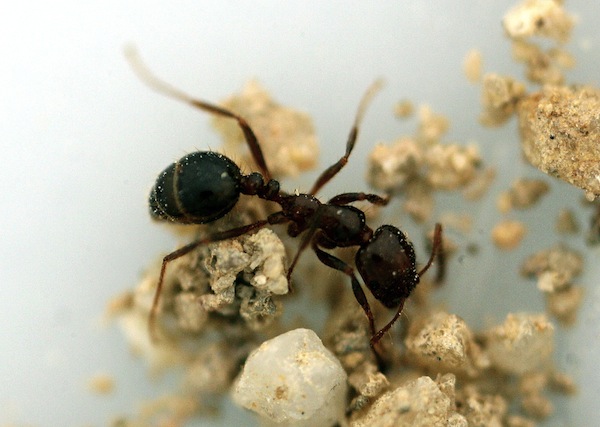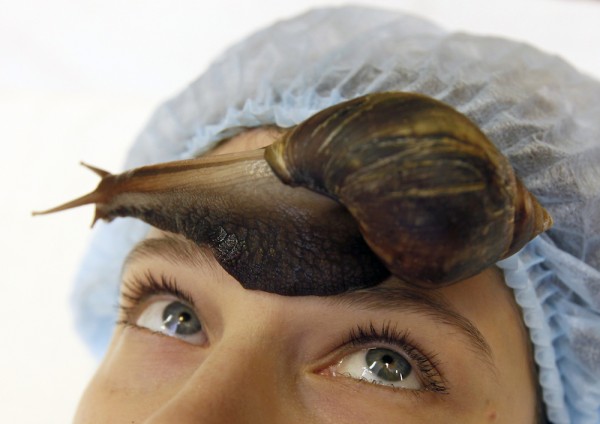China's Ecosystem Threatened by Foreign Invasive Species
| Michael A. Katz | | Dec 19, 2014 03:16 PM EST |
(Photo : Reuters) A spa customer in Russia receives a facial massage from a Giant African land snail, which is believed to remove wrinkles and scars. In Nigeria, they’re a delicacy. But in China, they’re voracious pests that can eat the paint and stucco off houses.
China has come under attack from a group of dangerous immigrants who, if left unabated, threaten to destroy the country. But it doesn't come from religious extremists or subversive foreign entities - it comes from flora and fauna such as the Giant African land snail or the Latin American red fire ant.
Like Us on Facebook
Experts are calling for new laws and regulations to grapple with the uncontrolled spread of invasive non-native species of plants and animals that is plaguing China, reports China state news agency Xinhua.
According to the fourth annual National Seminar on Biological Invasion, which was held this week in Nanning, 51 of the 100 most threatening invasive species in the world have been found in China.
More than 40 million trees die as a result of insects annually, two thirds of this are reportedly due to non-native species. And the influx of imported hazardous species is on the rise., Chinese customs agents found 500 batches of foreign pests 14 years ago. Last year, that number shot up to a staggering 610,000.
Before 2000, 25 invasive foreign species were known to have ever found their way into China. However, since then experts have already discovered 13 new species.

"In the decade before 2004, only one or two invasive species were found," said Liu Wanxue, an expert on biological invasion at the Chinese Academy of Agricultural Sciences. "But in the past 10 years, we have discovered at least one new non-native species each year."
Liu attributed the rise in invasive species to China's opening-up policy, and the increasing exchange of personnel and goods between foreign countries. As a result, Liu says that more non-native species are likely to enter the country.
Preventing the invaders from entering the country is one thing, but Chinese officials face additional problems trying to stem the spread of these species throughout the country once they get in.
And the species can be cleverly efficient at dispersing throughout the country, such as moving via the south-to-north water diversion project and its series of canals and pipelines, said Xie Songguang, a research fellow with the Chinese Academy of Sciences' Institute of Hydrobiology.
The east route of the diversion project, which connects the Yangtze River to other rivers and waterways offers a fertile route for the spread of highly invasive plants such as Cabomba caroliniana, an aquatic perennial from North America, Xie said.
In 2010, Xie found that the highly invasive Cabomba caroliniana, which was largely found in the lower parts of the Yangtze River, was moving north within China. He said the water diversion project may also facilitate the migration of 72 kinds of non-indigenous fish.
As the environmental toll mounts, experts have suggested ways to tackle the problem. For example, Lu Yongyue, a professor with the South China Agricultural University, said regional prevention and control is vital to controlling the invasive species..
"Take red imported fire ants," Lu told Xinhua. "It is impossible to eliminate them currently, but we can confine and kill them in some areas to minimize the damage they cause."
China currently does not have specific laws and regulations regarding the invasion of alien species. The government has issued a list of harmful agriculture and forestry pests, hasn't done much else to develop a comprehensive program to prevent them from entering the country.
TagsNational Seminar on Biological Invasion, China faces growing threats from invasive alien species, Giant African land snail, Cabomba caroliniana, invasive species, China's Ecosystem Threatened by Foreign Invasive Species
©2015 Chinatopix All rights reserved. Do not reproduce without permission
EDITOR'S PICKS
-

Did the Trump administration just announce plans for a trade war with ‘hostile’ China and Russia?
-

US Senate passes Taiwan travel bill slammed by China
-

As Yan Sihong’s family grieves, here are other Chinese students who went missing abroad. Some have never been found
-

Beijing blasts Western critics who ‘smear China’ with the term sharp power
-

China Envoy Seeks to Defuse Tensions With U.S. as a Trade War Brews
-

Singapore's Deputy PM Provides Bitcoin Vote of Confidence Amid China's Blanket Bans
-

China warns investors over risks in overseas virtual currency trading
-

Chinese government most trustworthy: survey
-

Kashima Antlers On Course For Back-To-Back Titles
MOST POPULAR
LATEST NEWS
Zhou Yongkang: China's Former Security Chief Sentenced to Life in Prison

China's former Chief of the Ministry of Public Security, Zhou Yongkang, has been given a life sentence after he was found guilty of abusing his office, bribery and deliberately ... Full Article
TRENDING STORY

China Pork Prices Expected to Stabilize As The Supplies Recover

Elephone P9000 Smartphone is now on Sale on Amazon India

There's a Big Chance Cliffhangers Won't Still Be Resolved When Grey's Anatomy Season 13 Returns

Supreme Court Ruled on Samsung vs Apple Dispute for Patent Infringement

Microsoft Surface Pro 5 Rumors and Release Date: What is the Latest?













